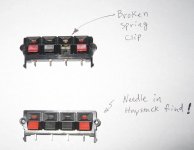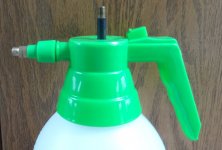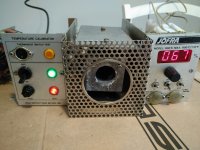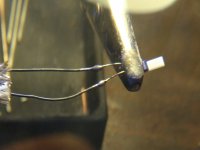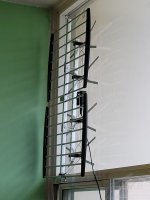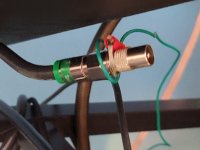Hopefully it was just a tempermental tube
Still running sweep tubes in triode? Been there, blown that.....too many times to try again.
Sometimes they would run for a month, sometimes a year, but it always ended the same way, red plate runaway causing either an open cathode resistor, maybe accompanied with a blown bypass cap, or just a blown fuse.
I replaced a spring clip terminal for the Hafler amp that I use for speaker testing/measurements.
Not so much a stupendous repair, but the fact that I finally found the exact replacement part was a stroke of luck.
One of the spring clips broke several years ago. (probably the best reason to no like the darn things!) I had searched for a drop-in replacement from time to time, but only recently found it a couple of weeks ago on NewEgg.
Anyway, it's just like new again.
Not so much a stupendous repair, but the fact that I finally found the exact replacement part was a stroke of luck.
One of the spring clips broke several years ago. (probably the best reason to no like the darn things!) I had searched for a drop-in replacement from time to time, but only recently found it a couple of weeks ago on NewEgg.
Anyway, it's just like new again.
Attachments
Well, I installed a new high voltage battery in a 2007 Camry Hybrid, but that is my day job.
Repaired an old Honda generator my wife picked up for $50, repaired some loose fiddly bits on the chicken coop, and serviced a nearly fifty year old Kmart/Lakewood fan that I have been running every night since I was a kid.
Oh, and still working away at the chassis for my Pete Millett Tube Electronic Crossover.
Dan
Repaired an old Honda generator my wife picked up for $50, repaired some loose fiddly bits on the chicken coop, and serviced a nearly fifty year old Kmart/Lakewood fan that I have been running every night since I was a kid.
Oh, and still working away at the chassis for my Pete Millett Tube Electronic Crossover.
Dan
Still running sweep tubes in triode? Been there, blown that.....too many times to try again.
Sometimes they would run for a month, sometimes a year, but it always ended the same way, red plate runaway causing either an open cathode resistor, maybe accompanied with a blown bypass cap, or just a blown fuse.
Always... I don't use fuses, and the cathode resistor was 10R. The tube didn't redplate, either. The amp uses an AB-4 autobiasing board so unless -105V on the grid isn't enough to shut down the runaway, it'll work. There's also open collector output so if it can't bias a tube, you can drive a transistor and relay to cut the power. I've had thermal runaway only on 6P45S (bad grid wiring) and 36LW6 (they just like to light up I think). None of my other sweep tubes have done it (mostly Soviet).
I think part of why they seem to work for me as triodes is I've never used them for SE, only PP
Last edited:
I have a USB dual channel scope i designed which ran at 10 mega samples/s.
Spent a bit of time tonight tweaking it and its now managing 14 mega samples/s.
Spent a bit of time tonight tweaking it and its now managing 14 mega samples/s.
I probably should have got it right first time !
After getting it as fast as possible I have to go back into pc software and start calibrating the scope from scratch.
Then the FFT spectrum analyser needs calibrating too.
 [/IMG]
[/IMG]

After getting it as fast as possible I have to go back into pc software and start calibrating the scope from scratch.
Then the FFT spectrum analyser needs calibrating too.


Last edited:
On a somewht less scale of sophistication...
I repaired my $4 spray bottle...
Been having trouble finding a good spray bottle for a moderately strong chlorine solution. This one immediately corroded, with the pump push-rod to blame. All rust flakes and plating chips fouling the pump seal, valve and coloring the solution itself. I realize it will continue to corrode the brass spray end - as I had to needle that clean.
So I got rid of it - no pump. Instead, fill it like a bicycle tire, about 15 psi does nicely. (I wonder what the burst pressure would be - when it blows the top off? Ah, I'm to old for such fiddelry...although at $4, I did pick up a 2nd)
I repaired my $4 spray bottle...
Been having trouble finding a good spray bottle for a moderately strong chlorine solution. This one immediately corroded, with the pump push-rod to blame. All rust flakes and plating chips fouling the pump seal, valve and coloring the solution itself. I realize it will continue to corrode the brass spray end - as I had to needle that clean.
So I got rid of it - no pump. Instead, fill it like a bicycle tire, about 15 psi does nicely. (I wonder what the burst pressure would be - when it blows the top off? Ah, I'm to old for such fiddelry...although at $4, I did pick up a 2nd)
Attachments
Last edited:
If I had to guess? The bottle will hold carbonated pop under pressure so pretty high. Pop in a bottle can reach 100 psi...
The problem I've always experienced with spraying bleach solutions from plastic bottles is that the plastic breaks down over time. Chlorine-resistant bottles are somewhat difficult to find on a whim, so I just buy the family-sized spray bottle of "chlorine cleaning solution", which is usually sold with a gallon jug for refills. The spray bottles do break eventually, but usually only after a multitude of re-uses.
And to stay on topic, my last repair was the replacement of an old "hard start" capacitor and relay on an outdoor A/C compressor unit. The original start cap had blown its guts after a decade or more of use. It took more time to buy the parts than it did to replace them.
And to stay on topic, my last repair was the replacement of an old "hard start" capacitor and relay on an outdoor A/C compressor unit. The original start cap had blown its guts after a decade or more of use. It took more time to buy the parts than it did to replace them.
I am much more comfortable solving intellectual problems than physical ones.
Mainly because experience tells me I tend to fall off ladders and cause significant injury to my person!
Anywhoo, the Gutter expert is visiting our Domicile today. Fixing our Gutters. Most of it can be remotely fixed.
But there's a broken joint up there too. I wouldn't go up a ladder for £250. But but he is up for it. 😎
Mainly because experience tells me I tend to fall off ladders and cause significant injury to my person!
Anywhoo, the Gutter expert is visiting our Domicile today. Fixing our Gutters. Most of it can be remotely fixed.
But there's a broken joint up there too. I wouldn't go up a ladder for £250. But but he is up for it. 😎
Attachments
Why are these monoblocs working perfectly until they clip?!
Because I might be lysdexic.... 510k instead of 150k makes 1.4Hz instead of 4.8Hz in the RC filter...
Corrected the error and these amps kill it!
Because I might be lysdexic.... 510k instead of 150k makes 1.4Hz instead of 4.8Hz in the RC filter...
Corrected the error and these amps kill it!
Also for some reason (Lots of RF, can't pick up AM, etc) I get less noise if I connect the turntable ground to the antenna in the window... Yes, some Canadians actually have an antenna even with "cable"
WTF?
WTF?
Attachments
Why are these monoblocs working perfectly until they clip?!
Because I might be lysdexic.... 510k instead of 150k makes 1.4Hz instead of 4.8Hz in the RC filter...
Corrected the error and these amps kill it!
Eliminating anything below 20Hz solves a lot of problems with amps.
Because there's really nothing down that low but record rumble, speaker feedback, and annoying, power wasting woofer flapping.
Once that crap is eliminated, or even reduced, more power is available for the music, where it matters.
I could never understand those amp manufacturer's touting such things as "DC to infinity", or advertising 5Hz to 50,000 Hz.....
Who listens to bass, or even singing that's additionally modulated by woofer flapping around at 5 to 10 Hz anyway?
Last edited:
There's actually a fair amount of fun stuff going on below 20 Hz. Depends on what you're listening to. (Pipe organs and/or movies, for just a couple of examples.)
There's actually a fair amount of fun stuff going on below 20 Hz.
Like the warp in the record.
Back in my early solid state days I built amps with extended low frequency response. I learned that you can indeed watch the woofer cone move in an out in step with the up and down of the tone arm tracking a non flat record......
And you can shred the the phenolic spider and pancake the voice coil in an old field coil speaker salvaged from a Hammond organ by slapping the strings on a bass guitar.
Excessive low frequency response in a tube amp with GNFB can lead to instability. The amp may not actually oscillate, but the bass may sound like that kid's boom boom boom car down the street.
Properly sized coupling caps are your friend.
In my case the caps were fine, it was the final stage grid leak resistors. Usually the final RC in my design is 33nF/100k, but this amp uses 22nF so needed 150k but somehow I put in 510k. Same colours, wrong order LOL
They are also the last point to point amps I still use. My others were scrapped and made with PCB.
They are also the last point to point amps I still use. My others were scrapped and made with PCB.
- Home
- Member Areas
- The Lounge
- What did you last repair?

